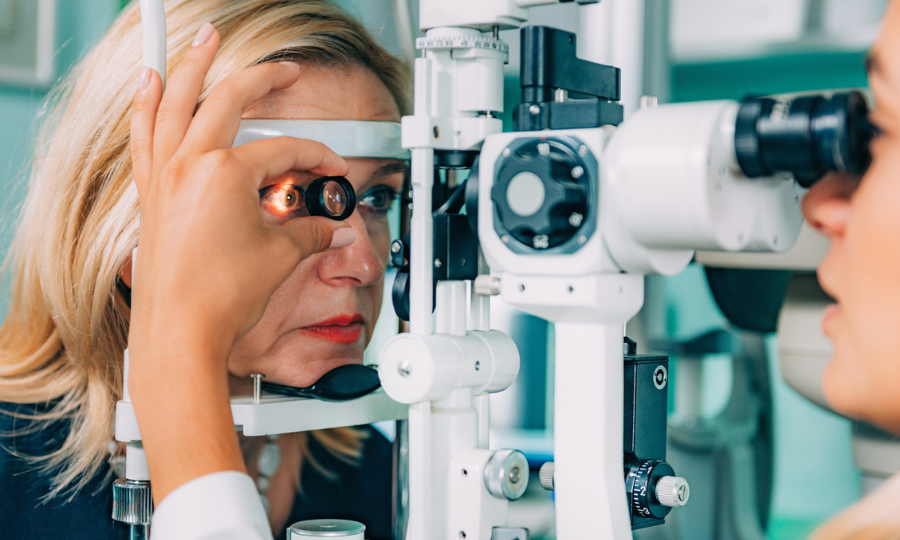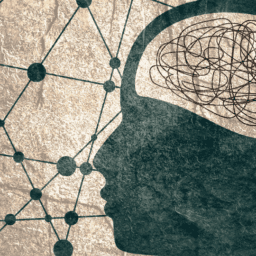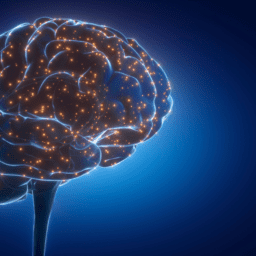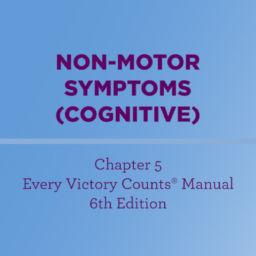Written by Daniel Gold, DO, and Ali G. Hamedani, MD MHS
Research has shown that visual symptoms are extraordinarily common in people living with Parkinson’s. Visual symptoms may occur due to changes in the front of the eye due to dry eye, changes in the retina (the part of our eyes that senses light), or changes in how our eyes move together. At the same time, many other things can affect vision, including diseases such as age-related macular degeneration, glaucoma, and cataracts, which increase with age. In this article, we’ll explore Parkinson’s and vision, including common visual problems and how to get the care you need to manage visual symptoms.
#1 – Everyone needs regular eye exams.
Even people with perfect eyesight should schedule regular eye exams as part of their preventative care routine. These exams are essential for screening for eye diseases and preserving your vision. Typically, an eye exam includes visual acuity tests (sharpness), depth perception tests, eye alignment, and eye movement. Your eye physician may also use eye drops to dilate your pupils, allowing them to check for common eye problems such as diabetic retinopathy, glaucoma, and age-related macular degeneration.
These are important for people with Parkinson’s to keep in mind for two reasons: first, up to half of all vision loss in the US is preventable or treatable with early detection through annual eye exams, and second, vision loss has a disproportionate impact on people with Parkinson’s: it increases the risk of falls, hip fractures, depression, anxiety, hallucinations, and dementia.
The American Academy of Ophthalmology recommends that all adults over 65 receive a comprehensive eye exam every one to two years. The recommended frequency of eye exams is every two to four years for age 40-54 and every one to three years for age 55-64. If you have a history of diabetes or are at an increased risk of glaucoma (for example, if you have a family history of glaucoma), you should have an eye exam every year regardless of age.
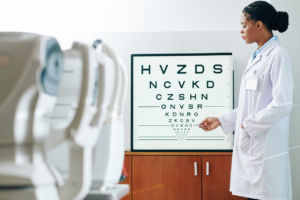 There are several different types of eye physicians. Ophthalmologists are medical physicians who have completed four years of medical school followed by four years of residency training in ophthalmology. They are experts in all aspects of eye disease, and most of them also perform surgery to treat eye conditions (cataracts, for example). Optometrists are healthcare providers who complete physician training in optometry but who have not attended medical school. They perform routine eye exams and prescribe glasses or contact lenses. If they detect a problem (such as glaucoma), they often refer to an ophthalmologist for further management, and they do not perform surgery. Neuro-ophthalmologists are either neurologists or ophthalmologists with expertise in visual symptoms from neurologic disease. They provide guidance on specific visual symptoms.
There are several different types of eye physicians. Ophthalmologists are medical physicians who have completed four years of medical school followed by four years of residency training in ophthalmology. They are experts in all aspects of eye disease, and most of them also perform surgery to treat eye conditions (cataracts, for example). Optometrists are healthcare providers who complete physician training in optometry but who have not attended medical school. They perform routine eye exams and prescribe glasses or contact lenses. If they detect a problem (such as glaucoma), they often refer to an ophthalmologist for further management, and they do not perform surgery. Neuro-ophthalmologists are either neurologists or ophthalmologists with expertise in visual symptoms from neurologic disease. They provide guidance on specific visual symptoms.
#2 – Like Parkinson’s, vision is linked to the brain.
Vision plays such a critical function that a substantial portion of our brain is made up of pathways that connect our eyes to the visual areas of our brain and the areas that help process this visual information (e.g., color, shape, size, motion). The primary purpose of the front part of our eyes (the cornea, lens, etc.) is to produce the clearest possible image, which is then transmitted to the back part of the eye, called the retina. The retina is made up of nerve cells that communicate via visual pathways using the neurotransmitter dopamine. In addition, we have two eyes with overlapping visual fields, which enables our brain to see the world in three dimensions and process complex visual information.
#3 – Vision problems are common in Parkinson’s.
Research has shown that visual symptoms are extraordinarily common in people living with Parkinson’s. Visual symptoms may occur due to changes in the front of the eye due to dry eye, changes in the retina (the part of our eyes that senses light), or changes in how our eyes move together. At the same time, many other things can affect vision, including diseases such as age-related macular degeneration, glaucoma, and cataracts, which increase with age. Distinguishing between visual symptoms caused directly by Parkinson’s versus one of these other conditions can be difficult.
Visual symptoms related to Parkinson’s can be specific: eyes can feel dry, gritty/sandy, and may burn or have redness. You may experience crusting on the lashes, lids that stick together in the morning, sensitivity to light, or dry eye. On the other hand, symptoms can be non- specific: you may notice your vision just isn’t what it used to be, and you have difficulty seeing on a rainy night, in dim lighting, or while reading, etc.
#4 – Parkinson’s impacts on vision can make everyday life more challenging.
Many of the visual symptoms experienced by people living with Parkinson’s are mild, and overall visual function can remain quite good with routine examinations by an eye care professional. However, multiple, small abnormalities in combination may become problematic and cause more significant symptoms. For example, difficulty with color vision and loss of contrast sensitivity (the ability to differentiate an object from its background) can make reading signs or walking down patterned stairs difficult. Problems with motion perception and clarity of vision can affect driving.
#5 – There is a wide array of vision problems people with Parkinson’s may experience.
Here are several common, and a few not-so-common, visual symptoms you may experience:
Blurry vision and difficulty with color vision. Blurry vision may be related to dopamine depletion in the back of the eye and within the visual connections through the brain. This may be partially corrected with dopaminergic medications, though medication effects are usually subtle regarding vision, so you may not notice them.
 Visual processing difficulty. This refers to the orientation of lines and edges, as well as depth perception. This can take different forms, including:
Visual processing difficulty. This refers to the orientation of lines and edges, as well as depth perception. This can take different forms, including:
- Troubles with peripheral vision: distracted by objects and targets in your peripheral vision
- Difficulties perceiving overlapping objects
- Difficulty copying and recalling figures (e.g., intersecting pentagons)
- Difficulties detecting whether motion is occurring and in which direction
- Difficulties recognizing faces, facial expressions, and emotions
Dry Eye. Dry eyes are a consequence of decreased blinking and poor production of tears. Dry eye can be worsened by certain medications prescribed for Parkinson’s. Dry eye improves with liberal use of artificial tears and good eye/eyelid hygiene. Of note, dry eye doesn’t always feel dry! Sometimes it feels like watering, and other times it just feels like blurring or being out of focus.
Double vision due to convergence insufficiency. Convergence insufficiency is a common problem that can interfere significantly with a person’s ability to focus on an object as it moves closer to them. This can be diagnosed during a routine examination by your eye care professional and often presents as seeing side-by-side or “double” images when reading. Other symptoms often emerge while reading or doing close work and include headaches, eye strain, blurry vision, short attention span, constant adjusting of the distance of a book, and loss of place on the page.
When double vision is experienced, the person living with Parkinson’s should cover each eye individually. If double vision resolves when covering either eye, this is probably a convergence problem. If there is still double vision in one eye when the other is covered, this is often due to dry eye or an optical/refractive disturbance. To help with convergence problems:
- Occasionally, eye exercises like “pencil push-ups” can help with convergence problems. Pencil push-ups involve slowly moving a small object, like the tip of a pencil, from arm’s length towards the nose, repeating 20 or so times a few times
a day for a few weeks. There’s no clear protocol or prescription for this, and it is usually much more effective in younger people recovering from head trauma, such as concussions - You could try an old trick of covering one eye or putting Scotch tape over one lens of your reading glasses to ensure only one eye is being used at a time
- Regarding glasses: reading glasses are preferable to bifocals or progressives since they provide a greater area of visibility for reading. Your eye physician can also fit reading glasses with prisms to help with double vision due to convergence insufficiency
Hallucinations. Hallucinations can result from Parkinson’s itself or be exacerbated by medications used to treat Parkinson’s. While it never hurts to inform your eye care professional about hallucinations you are experiencing, you should discuss these in detail with your movement disorder specialist or other physician.
#6 – There are many types of professionals who can help.
While there are no proven ways to prevent most ocular conditions from developing, routine visits with an eye care professional can lead to early recognition and treatment of eye issues before they harm your quality of life. Between you, your neurologist, and an ophthalmologist, most visual complaints can be handled. However, when symptoms remain unchanged and unexplained, consultation with a neuro-ophthalmologist is probably warranted.
A neuro-ophthalmologist is either a neurologist or an ophthalmologist with fellowship training in neuro-ophthalmology. Neuro-ophthalmologists have a unique appreciation for the intersection of the eyes and the brain and perform comprehensive testing in the office to determine where a visual or eye movement problem could originate. Once the location of the disturbance is identified, diagnostic testing (when appropriate), treatments, and therapies can be customized depending on the individual and their concerns(s).
 While your eye care professional may not be aware of common ocular symptoms that people living with Parkinson’s experience, explaining the kinds of situations and triggers that bring on eye symptoms is usually enough for your physician to know where to look during the examination (e.g., front part of the eye, back part of the eye, movements of the eyes). Keeping a journal or diary of symptoms can also be helpful for both you and your physician.
While your eye care professional may not be aware of common ocular symptoms that people living with Parkinson’s experience, explaining the kinds of situations and triggers that bring on eye symptoms is usually enough for your physician to know where to look during the examination (e.g., front part of the eye, back part of the eye, movements of the eyes). Keeping a journal or diary of symptoms can also be helpful for both you and your physician.
About Daniel Gold
Daniel Gold, DO, is an assistant professor of neurology, ophthalmology, otolaryngology – head & neck surgery and neurosurgery at The Johns Hopkins School of Medicine in Baltimore, Maryland. He is a neurologist with fellowship training in neuro-ophthalmology. Dr. Gold has additional training in vestibular neurology and also sees patients with dizziness and imbalance. He is the director of Urgent Neurology, and has a particular interest in the rapid diagnosis and treatment of acute neuro-ophthalmologic and vestibular disorders. Dr. Gold completed his DO at the University of Medicine and Dentistry of New Jersey – School of Osteopathic Medicine. He completed his residency in neurology at the University of Maryland and his fellowship in neuro-ophthalmology at the Hospital of the University of Pennsylvania.
About Ali Hamedani, MD MHS
Ali Hamedani, MD, MHS, is a neuro-ophthalmologist and movement disorder specialist at the University of Pennsylvania. He earned his Bachelor of Science in Biology at Yale University and his MD at the University of Maryland School of Medicine. He also holds a master’s degree in epidemiology from the Johns Hopkins Bloomberg School of Public Health. Dr. Hamedani joined the faculty after completing his neurology residency and fellowship training at the University of Pennsylvania. Dr. Hamedani’s primary clinical focus is neuro-ophthalmology, which is the study of visual symptoms from neurologic disease, and he has a particular interest in visual dysfunction in Parkinson’s and other movement disorders. His research uses national health surveys and administrative claims data to understand how vision affects outcomes and quality of life in Parkinson’s and other patient populations.
WANT MORE PRACTICAL ARTICLES LIKE THIS?
You can find much more in our Every Victory Counts® manual. It’s packed with up-to-date information about everything Parkinson’s, plus an expanded worksheets and resources section to help you put what you’ve learned into action. Request your free copy of the Every Victory Counts manual by clicking the button below.
Thank you to our 2021 Peak Partners, Adamas, Amneal, Kyowa Kirin, and Sunovion, as well as our Every Victory Counts Gold Sponsor AbbVie Grants, Silver Sponsor Lundbeck, and Bronze Sponsors Supernus and Theravance for helping us provide the Every Victory Counts manual to our community for free.


